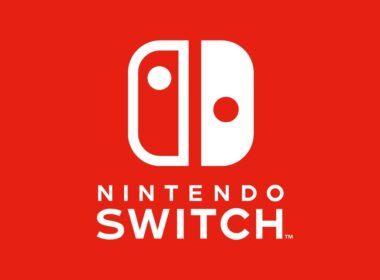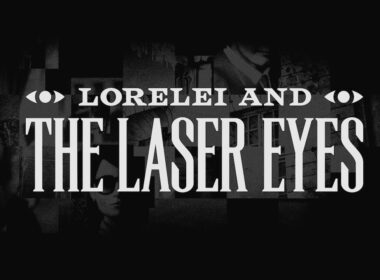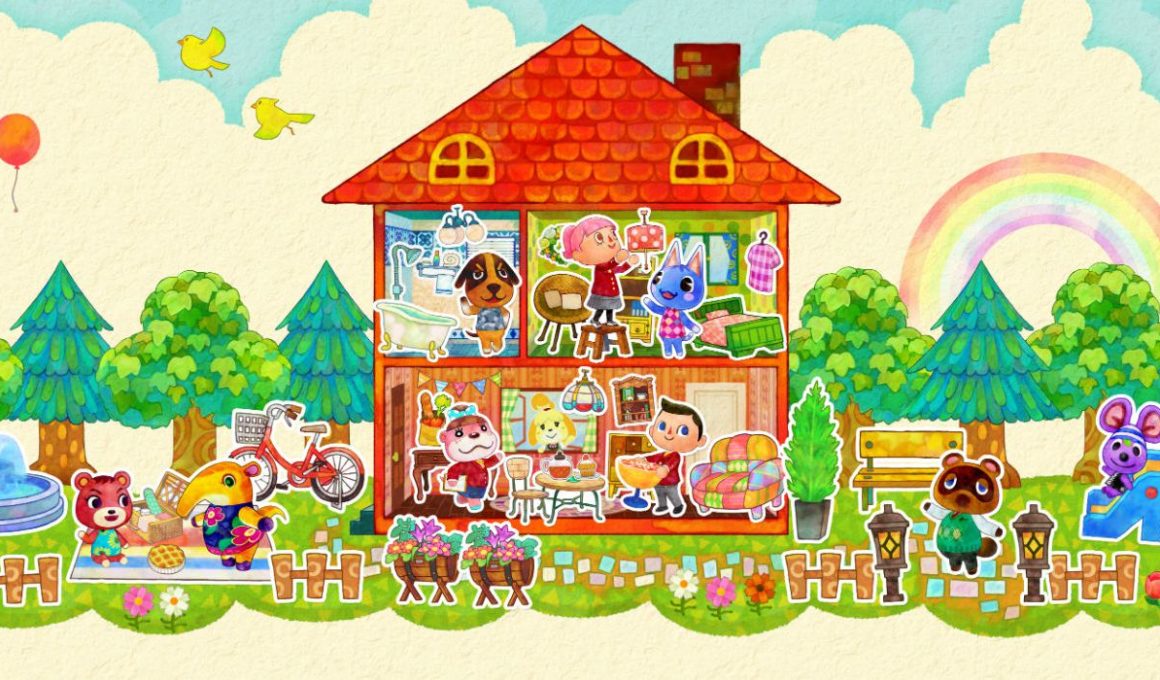Nintendo had once admitted that they were left “dumbfounded” by the success that Animal Crossing: New Leaf was met with. But, taking encouragement from such reaction, the company immediately began brainstorming ideas as to which direction they should take their cheery animal cast next.
That has resulted in Wii U and Nintendo 3DS exclusives Animal Crossing: amiibo Festival and Animal Crossing: Happy Home Designer and while we prepare for party antics later this year, Nintendo has chosen to firstly put our interior decorating skills to the test.
Hired as the newest employee at Nook’s Homes, after a brief welcome from your new colleagues you’re asked to swap out your drab grey suit for a bolder outfit reminiscent of Butlins redcoats. Tom Nook’s latest investment of his amassed Bells has seen the business-minded raccoon open a decorating company in an entirely new neighbourhood, and, clipboard in hand, you will help animals moving to the town with their home decorating needs.
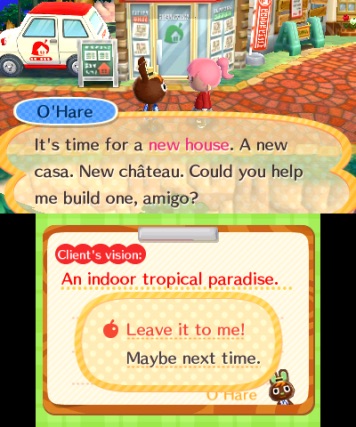
You are supported by Lyle, Digby and home design expert Lottie, who will provide guidance in helping you to get started in your fledgeling career. Nook appears every now and then to check on how you are doing, but largely runs Nook’s Homes from behind the scenes.
Playing through Animal Crossing: Happy Home Designer’s opening hours, Lottie’s progressive training will see your work shift from simple interior design to new-home construction. It acts as a gentle learning curve, easing newcomers and well-versed players alike in how to successfully unleash their inner designer. That comes in attentively listening to each animal’s request, which will specifically share what style they would like you to theme their home around.
Whether they want their abode resplendent in pink, with spooky ornaments, or wanting to set up a new office space for their business, players will rely on the Catalog to select whichever wallpaper, flooring and furniture best matches their desired theme. It can be a time-consuming process as you carefully place everything in the room, orienting their position and being meticulous to meet your client’s lofty expectations. That said, I still haven’t had any characters complain about my design efforts, not that I have really gone out of my way to go against their creative wishes.
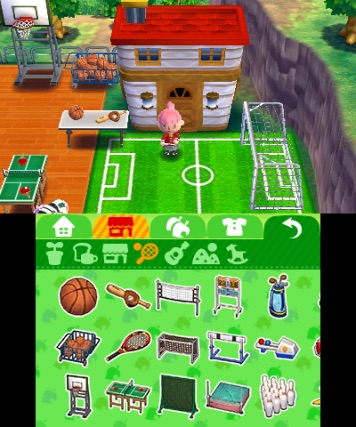
As your success continues, Nook shares how impressed he has been with your work and promotes you as project leader of town development. This sees you work together with Isabelle – a familiar face to those that poured countless hours into New Leaf – as you rebuild the abandoned town that surrounds Nook’s Homes. This opens up Animal Crossing: Happy Home Designer to larger projects that go far beyond the houses that provide the bulk of the experience.
Isabelle’s first official project is a school, where players must populate a wide open classroom with the relevant furniture and items. This soon moves on to a hospital where you must complete a reception, doctor’s office and patient’s ward, and later sees you tasked with preparing a department store, restaurant, office and more.
Selecting and placing items is absolutely effortless, which is important considering it is core to the experience. The Nintendo 3DS touch screen provides a clear, top-down overview of the room that you are currently remodelling. The Catalog’s icons are aligned across the top, separated into wallpaper and carpets, furniture, wall-mounted furniture and rugs, with a search icon allowing designers to hunt for furniture by colour, name and those recently added.
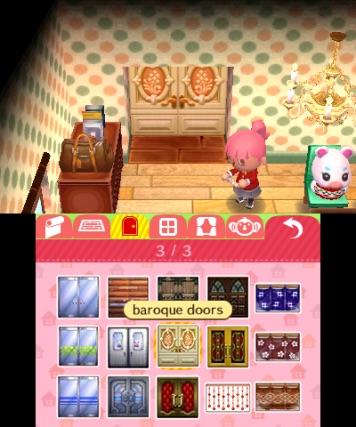
Anything chosen will appear in the room with players free to tap with the stylus to rotate it or hold to drag it to another position. Certain items can be placed on top of others – such as a lamp on top of a table – whereas animals and Isabelle’s projects will specify items that must be incorporated into your design. These often provide a helpful starting point and will encourage younger players that may need a push in the right direction.
Those daunted by larger spaces will be reassured by the ability to copy items by pressing the L or R Button and tapping whichever you wish to duplicate, while you can move groups of furniture by dragging over an area on the touchscreen. It’s certainly nice to see Nintendo looking for ways to save the player’s time.
Players can only take on one project per day, after which they return to their desk at Nook’s Homes to write their daily report. No actual writing is involved, but this acts as a prompt to frequently save your progress – a welcome move considering the increasing amount of time that remodels can take you to complete.
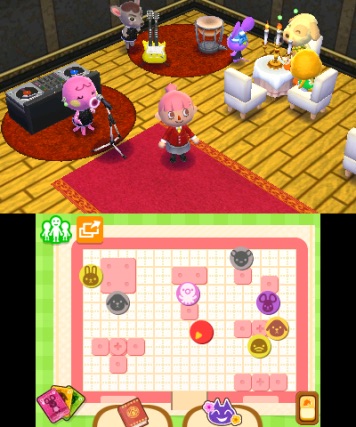
I did have immediate concerns that beneath Animal Crossing: Happy Home Designer’s infectiously charming sheen lay a restrictively barebones experience but was soon proved wrong on multiple accounts.
Once you have completed enough projects, Nook will hand you the Happy Home Handbook. This invaluable tome includes lessons that will unlock new ways to design houses and facilities, such as selecting between room layouts, customising windows and curtains, or adding atmospheric sounds. But while the first lesson is free, the rest will cost between 1 – 5 Play Coins. Only one new lesson may be learned per in-game day, meaning that this shouldn’t be too much of a concern for those that carry their Nintendo 3DS with them on the go.
When you have remodelled a home, you can also choose to make a return visit. This allows players to change the resident’s clothes with new outfits that you have collected, tweak their humble abode further with new furniture that you have gathered, or use Animal Crossing amiibo cards to invite other characters to visit.
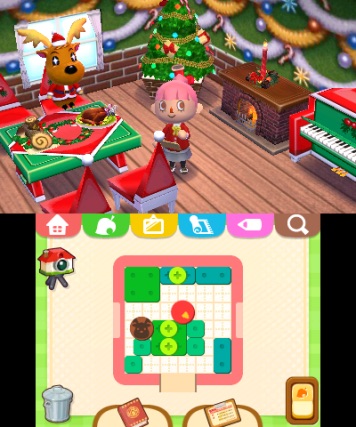
These are otherwise used by using the amiibo Phone in Nook’s Homes, with players calling whichever character is on their chosen card. That will allow you to accept their requests and can unlock more furniture for you to use, whereas any data for the character’s house will be written to the amiibo card. This may be used in other games that are compatible with the cards, which I presume could bear some significance in Animal Crossing: amiibo Festival.
Criticism can be aired at Animal Crossing: Happy Home Designer’s lack of constructive feedback. As you fill rooms with furniture and trinkets, it is never made clear as to how closely you are keeping to your client’s request. Hearts will flutter above their heads when you select something that they like, but more grading of your overall effort would have been appreciated. This would also encourage you to revisit homes that you remodelled earlier in the game to spruce them up with everything that you have since unlocked.
Nintendo pushes Animal Crossing: Happy Home Designer as an experience to share on social media, with players encouraged to snap screenshots to post on Miiverse and through the Nintendo 3DS Image Share tool. The Happy Home Network expands on that in allowing players to share their created projects, which are then open to being rated and visited by others online. Accessed through a computer in Nook’s Homes, with creations easy to find through project numbers and QR Code patterns. Nintendo also promises special Happy Home Challenge contests that will see players compete with projects with a specific theme, which will help objectify your playtime.
After years of mayoral duties, Animal Crossing: Happy Home Designer’s fresh lick of paint results in a heartwarming approach that successfully recaptures that irresistible Animal Crossing magic. Challenged to do your best every day, this was one job that proved itself to be particularly rewarding.
Version Tested: Nintendo 3DS
Review copy provided by Nintendo


